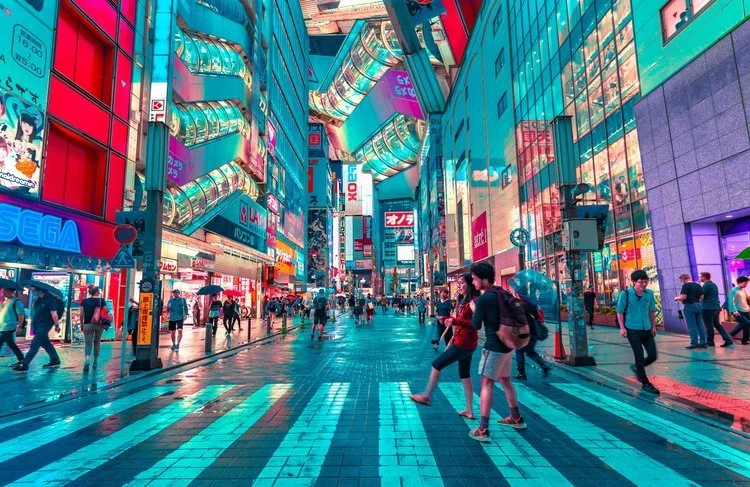Special Edition Tokyo
“Culture isn’t just market research—it’s market creation.” — Akiko Tanaka
What's Essential This Week
Micro-Mobility with Aesthetics: Luup scooters aren't just transportation—they're designed as cultural objects first, vehicles second. The signal for global markets: in post-pandemic cities, a function without Instagram appeal fails before launch.
The K-Beauty Plateau: Korean cosmetics level off as Japan's "sensitive skin philosophy" advances. The shift matters beyond beauty: restraint over novelty is winning premium positioning across categories.
Subscription Fatigue Recovery: Japan's "mono-subscription" culture—deep loyalty to a single service over portfolio sprawl—is shaping how Netflix, Spotify, and SaaS platforms rethink retention. The signal: loyalty beats variety. Depth beats breadth.
Market Movements Worth Tracking
Quiet Luxury, Localized: Brunello Cucinelli thrives in Tokyo not through European playbooks, but by embedding omotenashi service rituals into every customer interaction.
The result: conversion rates 23% higher than their European stores.
The lesson: cultural adaptation isn't translation—it's transformation.
Co-Working as Culture: Local models succeed where WeWork stumbled because they don't just offer desks—they double as cultural incubators. The spaces host exhibitions, salons, and community rituals that make membership feel less like a subscription and more like belonging.
Analog Renaissance: Film cameras, vinyl, and handwritten notes surge among digital natives. Camera no Kitamura reports a 340% increase in film processing among 18-25-year-olds. The pattern extends beyond nostalgia: in a world drowning in digital, analog becomes premium.
The Competitive Edge: What Western Executives May Miss
This is where market entry strategies succeed or quietly fail—often before anyone realizes why.
The Gift Economy
Omiyage culture isn't about presents—it's about relationship architecture. Western executives miss this distinction: giri (social obligation) and ninjo (human feeling) aren't customs to be observed. They're competitive advantages to embed.
The firms that understand this close partnerships six months faster than those who see gift-giving as politeness theater. Those that don't trigger invisible exits—polite withdrawals that leave Western executives confused about what went wrong.
Meeting Culture as Strategy
Nemawashi—building consensus before the formal meeting—looks like bureaucracy to Western executives. It's not. It's decision architecture.
The "real meeting" happens in the weeks before anyone enters a conference room. By the time you're presenting, outcomes are already determined. Firms that treat nemawashi as a process report 67% higher partnership success rates. Those who see it as an obstacle create opposition that they never understand.
The adjustment isn't about patience. It's about recognizing where decisions actually happen.
Language Hacks That Matter
"Yoroshiku Onegaishimasu": This isn't politeness—it signals mutual commitment to relationship success. Use it at the beginning of relationships, not during negotiations. The difference matters.
The Pause Protocol: Silence means thoughtfulness, not disengagement. Western executives fill pauses, mistaking them for awkwardness. Japanese executives use them for processing. Could you wait four to six seconds before responding? The strategic pause is your competitive advantage, not a gap to fill.
Category Creators Who Reshaped Global Business
Two executives shaped how the world does business with Japan—not through market entry strategies, but by exporting cultural frameworks that changed entire industries:
Nigo: His drop-culture playbook—scarcity through intentional limited releases—reshaped product launches from sneakers to software. What started as a streetwear strategy is now a SaaS go-to-market doctrine. Restricted access isn't artificial scarcity; in Japan, it's cultural authenticity.
Hiroshi Mikitani: Rakuten's CEO fused omotenashi hospitality principles with e-commerce infrastructure. The lesson wasn't about technology—it was about cultural values scaling digital markets. Service excellence isn't a feature; it's the foundation that makes everything else possible.
Investment Intelligence: Back, Watch, Avoid
Back: Craft Digitalization Heritage artisans digitizing without losing authenticity. Why it matters: This model prevents the "digital commodity trap" from killing Western artisan brands. Watch companies that preserve craft integrity while achieving digital scale.
Watch: Over-Automation Backlash: High-end restaurants removing tablets. Hotels emphasizing human service over efficiency. The signal: there's a ceiling to what consumers will trade for convenience. The firms betting on premium human experience may be early, not wrong.
Avoid: Generic Wellness Japan's shinrin-yoku (forest bathing) resists Western commodification because it's rooted in Shinto tradition, not lifestyle trends. Western wellness brands that try to package it misunderstand its cultural foundation. What works as authentic practice fails as an imported product.
The Field Report: What We're Hearing on the Ground
Cultural Due Diligence Enters M&A: Anthropologists now join deal teams because cultural misalignment kills more acquisitions than financial structure. The question isn't whether cultures match—it's whether leadership understands what alignment actually requires.
Emerging Pattern: Japanese firms are "reverse-engineering" Western digital models through cultural lenses—producing higher engagement and lower churn than their Silicon Valley equivalents. The surprise isn't that culture matters. It's that culture that delivers better unit economics.
What's Next: The Soft Power Competition
As Tokyo and Seoul compete for global soft power influence—Tokyo through kawaii culture, Seoul through hallyu—the lesson for Western executives becomes clear: culture isn't marketing. It's infrastructure.
Both cities prove that cultural strategy compounds economic advantage over decades, not quarters. The question for global businesses isn't whether to understand this; it's how. It's whether you'll realize it before your competition does.
Tokyo doesn't just show you tomorrow's consumer. It shows you how cultural intelligence becomes a competitive moat.
Join the Conversation
This is part of Metropolitan Review—my series on cities shaping global business from the inside, not the conference rooms.
Next edition: Seoul's founder economy and why Korean startup culture is reverse-engineering Silicon Valley's playbook with better results.
Your perspective matters: If you're navigating Tokyo—or any market where culture drives commerce more than capital—I'd value hearing what patterns you're seeing. The best intelligence comes from leaders building in these markets, not analysts observing from outside.

